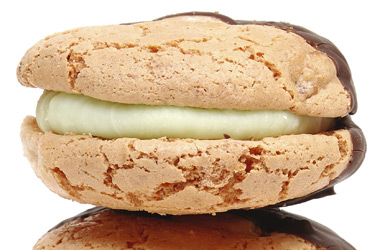God, what a treat it is. It’s like a dessert that goes on and on. If you’re tired of watching the country wallow deeper and deeper into a diabetes epidemic, the suit now in progress between sugar and corn syrup will be more of a hoot to watch than the Superbowl.
High-fructose corn syrup—HFCS for short—has brought down the wrath of Big Sugar by trying to rechristen itself “corn sugar.” Sugar doesn’t want corn syrup to call itself “sugar” for fear people will get the idea that the treacly stuff is really just another form of the sugar we know best, which comes from cane or beets (yes, there still is a beet sugar industry in the U.S.).
HFCS infiltrated the market with its sticky presence partly because the U.S. shied away from previously ubiquitous cane sugar when Castro took over Cuba. Around the same time, corn growers won federal subsidies that shoved down the price of their product. By the early 1970s, American were consuming a little more than a pound of HFCS per year in food and drinks. By 1980, they were taking in more than 14 pounds a year. By the millennium, HFCS was everywhere—in baked goods, sauces, condiments, soft drinks, you name it—and the average American was fattening up on 63 pounds per annum of HFCS.
HFCS is hard to escape, but in recent years there’s been a backlash against it on the parts of people concerned enough to read the labels on food containers. The corn syrup industry, stung by the fact that consumers and certain retailers have been shunning its product, has launched a campaign with slogans like “your body can’t tell the difference” (i.e. between HFCS and sugar)—a statement many nutritionists dispute because of evidence that the syrup is metabolized faster than sugar, and that it expends more calories to produce the same degree of sweetness.
(A Princeton study done two years ago found that “male rats given water sweetened with high-fructose corn syrup in addition to a standard diet of rat chow gained much more weight than male rats that received water sweetened with table sugar, or sucrose, in conjunction with the standard diet.”)
In any event, the corn syrup industry’s petition to the federal Food and Drug Administration to change HFCS’s name to corn sugar is an attempt to overhaul the image of the stuff—by misleading consumers, according to sugar and its allies. A bonbon of a quote comes from James S. Turner, an attorney with Citizens for Health, which has signed on to the suit as an ally of the cane-beet camp: “If sugar wanted to change its name to ‘highly nutritious vitamins,’ we would oppose that, too.”
Sugar—in the person of attorney Adam Fox, who’s representing Western Sugar Corp. and its fellow plaintiffs in the suit—also complains that corn syrup is touting itself as “natural” when in fact it’s a highly processed product. (In the past, some HFCS has even been found to contain mercury because mercury was sometimes used to produce caustic soda, a reagent involved in the manufacture of HFCS. The corn syrup industry says the reagents used in making the sweetener are now mercury-free.)
Whatever happens in court, this fight between the Tweedle Dum and Tweedle Dee of an oversweetened food landscape provides a chance to recap some home truths, the chief being that we’re eating way too much of both, and it’s not entirely our fault.
Competition between processed food companies has spiked the American diet with more salt and sugar—or sweeteners (heaven forbid we should incur the wrath of Big Sugar by confounding it with corn syrup or Sweet and Low)—than it had 40 or 50 years ago. That’s why a lot of people’s blood sugar is on a roller coaster: their food is juiced up with stuff that raises their blood pressure and drives their insulin crazy. Among the yards and yards of breakfast cereal on the grocery store shelf, for example, there’s a very limited choice of brands that aren’t pre-sweetened. Even the faux-healthy muesli and granola types taste like candy when you get them home.
The result, according to nutritionists, is that we’re all addicted to our food rather than just being satisfied by it. Dr. Mark Hyman, physician, founder of the UltraWellness Center and a popular nutrition guru on public television, points out that “Cane sugar and high fructose corn syrup are indeed both harmful when consumed in pharmacologic doses of 140 pounds per person per year,” the amount we’re all scarfing in the era of what Hyman calls “diabesity.”
But Hyman cautions that corn syrup is, chemically and metabolically, not the same as sugar, and advises listeners not to buy any product with corn syrup on its label. In the meantime, those of us who haven’t yet reached Hyman’s nirvana of micronutrient-fueled wellbeing can sit on the couch with our ice cream and Oreos and watch sugar and corn syrup slug it out in court.



